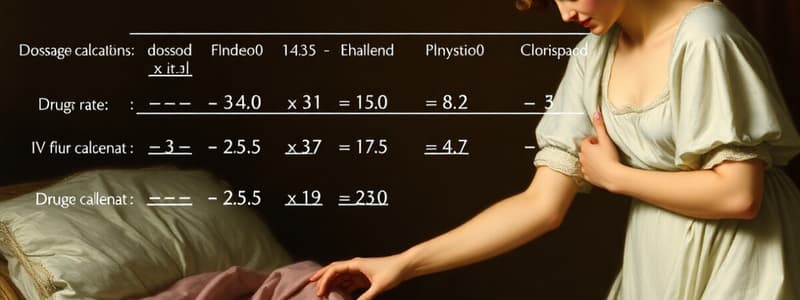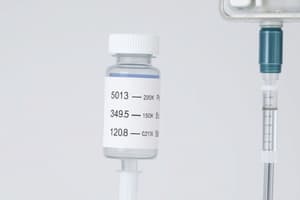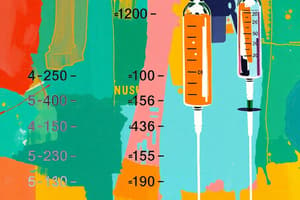Podcast
Questions and Answers
Convert 2.5 g to mg.
Convert 2.5 g to mg.
- 25,000 mg
- 0.25 mg
- 2,500 mg (correct)
- 250 mg
The provider orders 500 mL of D5W to be infused over 4 hours. What is the flow rate in mL/hr?
The provider orders 500 mL of D5W to be infused over 4 hours. What is the flow rate in mL/hr?
- 125 mL/hr (correct)
- 100 mL/hr
- 175 mL/hr
- 250 mL/hr
The physician prescribes 0.75 g of a medication. The available supply is 250 mg per tablet. How many tablets should the nurse administer?
The physician prescribes 0.75 g of a medication. The available supply is 250 mg per tablet. How many tablets should the nurse administer?
- 1 tablet
- 4 tablets
- 3 tablets (correct)
- 2 tablets
A client is ordered 1.2 g of amoxicillin. The medication comes as 400 mg per 5 mL. How many mL should the nurse administer?
A client is ordered 1.2 g of amoxicillin. The medication comes as 400 mg per 5 mL. How many mL should the nurse administer?
The order is for 0.3 g of a drug. The available supply is 100 mg per capsule. How many capsules should the nurse administer?
The order is for 0.3 g of a drug. The available supply is 100 mg per capsule. How many capsules should the nurse administer?
Convert 30 mL to tablespoons.
Convert 30 mL to tablespoons.
The order is 5 mg/kg for a child weighing 44 lbs. The available medication is 50 mg per mL. How many mL should the nurse administer?
The order is 5 mg/kg for a child weighing 44 lbs. The available medication is 50 mg per mL. How many mL should the nurse administer?
A patient is ordered 125 mcg of digoxin. The medication is available as 0.25 mg per tablet. How many tablets should the nurse administer?
A patient is ordered 125 mcg of digoxin. The medication is available as 0.25 mg per tablet. How many tablets should the nurse administer?
Convert 3 tsp to mL.
Convert 3 tsp to mL.
The order is for 1,000 mL of NS over 8 hours. What is the IV flow rate in mL/hr?
The order is for 1,000 mL of NS over 8 hours. What is the IV flow rate in mL/hr?
A provider orders 1 L of D5NS over 5 hours. What is the flow rate in mL/hr?
A provider orders 1 L of D5NS over 5 hours. What is the flow rate in mL/hr?
An IV is running at 30 gtt/min with a drop factor of 15 gtt/mL. What is the IV flow rate in mL/hr?
An IV is running at 30 gtt/min with a drop factor of 15 gtt/mL. What is the IV flow rate in mL/hr?
The order is 50 mL of an antibiotic to be infused over 30 minutes using a pump. What is the IV rate in mL/hr?
The order is 50 mL of an antibiotic to be infused over 30 minutes using a pump. What is the IV rate in mL/hr?
A patient is receiving 200 mL/hr of NS. How long will a 1 L bag last?
A patient is receiving 200 mL/hr of NS. How long will a 1 L bag last?
The provider orders 400 mg of medication in 250 mL of NS to infuse over 2 hours. What is the infusion rate in mL/hr?
The provider orders 400 mg of medication in 250 mL of NS to infuse over 2 hours. What is the infusion rate in mL/hr?
The order is 500 mL of LR to infuse at 75 mL/hr. How long will it take to complete the infusion?
The order is 500 mL of LR to infuse at 75 mL/hr. How long will it take to complete the infusion?
A patient needs 1,000 mL of D5W over 10 hours. What is the flow rate in mL/hr?
A patient needs 1,000 mL of D5W over 10 hours. What is the flow rate in mL/hr?
The doctor orders 75 mg of a drug in 100 mL NS over 45 minutes. What is the IV rate in mL/hr?
The doctor orders 75 mg of a drug in 100 mL NS over 45 minutes. What is the IV rate in mL/hr?
A medication is ordered at 250 mL over 2 hours. What is the rate in mL/hr?
A medication is ordered at 250 mL over 2 hours. What is the rate in mL/hr?
The order is 15 mg/kg/day divided BID for a child weighing 22 lbs. What is the dose per administration?
The order is 15 mg/kg/day divided BID for a child weighing 22 lbs. What is the dose per administration?
A child is prescribed 40 mg/kg of acetaminophen. The child weighs 18 kg. How many mg should be given?
A child is prescribed 40 mg/kg of acetaminophen. The child weighs 18 kg. How many mg should be given?
A newborn is prescribed 5 mg/kg of a drug. If the baby weighs 3.2 kg, how many mg should be given?
A newborn is prescribed 5 mg/kg of a drug. If the baby weighs 3.2 kg, how many mg should be given?
A medication order is 0.5 mg/kg per dose. The child weighs 30 kg. What is the total dose?
A medication order is 0.5 mg/kg per dose. The child weighs 30 kg. What is the total dose?
A child is ordered 20 mg/kg/day divided TID. If the child weighs 15 kg, how much per dose?
A child is ordered 20 mg/kg/day divided TID. If the child weighs 15 kg, how much per dose?
The order is 5 units/kg of heparin. The patient weighs 70 kg. How many units should be given?
The order is 5 units/kg of heparin. The patient weighs 70 kg. How many units should be given?
A patient is prescribed 8 units/kg of insulin. The patient weighs 60 kg. How many units should be given?
A patient is prescribed 8 units/kg of insulin. The patient weighs 60 kg. How many units should be given?
A heparin drip is ordered at 18 units/kg/hr for a patient weighing 75 kg. The IV bag contains 25,000 units in 500 mL. What is the mL/hr rate?
A heparin drip is ordered at 18 units/kg/hr for a patient weighing 75 kg. The IV bag contains 25,000 units in 500 mL. What is the mL/hr rate?
A patient is ordered dopamine at 5 mcg/kg/min. The patient weighs 80 kg. The IV bag contains 400 mg in 250 mL. Calculate mL/hr.
A patient is ordered dopamine at 5 mcg/kg/min. The patient weighs 80 kg. The IV bag contains 400 mg in 250 mL. Calculate mL/hr.
An order is for norepinephrine at 8 mcg/min. The IV contains 4 mg in 250 mL. Calculate mL/hr.
An order is for norepinephrine at 8 mcg/min. The IV contains 4 mg in 250 mL. Calculate mL/hr.
A patient is on an insulin drip at 4 units/hr. The bag contains 100 units in 250 mL. Calculate the mL/hr rate.
A patient is on an insulin drip at 4 units/hr. The bag contains 100 units in 250 mL. Calculate the mL/hr rate.
A nitroglycerin drip is ordered at 10 mcg/min. The IV bag contains 50 mg in 250 mL. Calculate mL/hr.
A nitroglycerin drip is ordered at 10 mcg/min. The IV bag contains 50 mg in 250 mL. Calculate mL/hr.
A medication order requires 4.267 mL. How should this be rounded?
A medication order requires 4.267 mL. How should this be rounded?
The doctor orders 1.578 g of medication. How should it be rounded if available in 0.1 g increments?
The doctor orders 1.578 g of medication. How should it be rounded if available in 0.1 g increments?
A patient is prescribed 2.745 mg of medication, available in 2.5 mg or 3 mg tablets. What dose should be administered?
A patient is prescribed 2.745 mg of medication, available in 2.5 mg or 3 mg tablets. What dose should be administered?
An IV rate is calculated as 87.56 mL/hr. How should it be rounded?
An IV rate is calculated as 87.56 mL/hr. How should it be rounded?
A child's dose is calculated as 3.248 mL. How should this be rounded for an oral syringe?
A child's dose is calculated as 3.248 mL. How should this be rounded for an oral syringe?
A drug is prescribed at 10 mg/kg/day in two divided doses for a 30 kg child. The safe range is 5-15 mg/kg/day. Is this safe?
A drug is prescribed at 10 mg/kg/day in two divided doses for a 30 kg child. The safe range is 5-15 mg/kg/day. Is this safe?
A patient is ordered 500 mg of a drug. The safe dose range is 5-10 mg/kg/day. The patient weighs 70 kg. Is this dose safe?
A patient is ordered 500 mg of a drug. The safe dose range is 5-10 mg/kg/day. The patient weighs 70 kg. Is this dose safe?
A medication is ordered at 2 mg/kg/day. The patient weighs 50 kg. The safe range is 100-150 mg/day. Is the dose safe?
A medication is ordered at 2 mg/kg/day. The patient weighs 50 kg. The safe range is 100-150 mg/day. Is the dose safe?
A pediatric dose is 7 mg/kg/day, with a safe range of 5-8 mg/kg/day. If the child weighs 18 kg, is it safe?
A pediatric dose is 7 mg/kg/day, with a safe range of 5-8 mg/kg/day. If the child weighs 18 kg, is it safe?
The max daily acetaminophen dose is 75 mg/kg/day. A 20 kg child receives 1,000 mg every 6 hours. Is it safe?
The max daily acetaminophen dose is 75 mg/kg/day. A 20 kg child receives 1,000 mg every 6 hours. Is it safe?
Flashcards
g to mg conversion
g to mg conversion
Conversion between grams (g) and milligrams (mg). 1 g = 1000 mg
L to mL conversion
L to mL conversion
To convert liters (L) to milliliters (mL), multiply the number of liters by 1000.
IV flow rate
IV flow rate
Process of finding out how many mL of fluid infuse per hour.
Safe Dose Range
Safe Dose Range
Signup and view all the flashcards
Round IV rates
Round IV rates
Signup and view all the flashcards
Titration
Titration
Signup and view all the flashcards
mL to Tablespoon Conversion
mL to Tablespoon Conversion
Signup and view all the flashcards
Safe Dosage Parameter
Safe Dosage Parameter
Signup and view all the flashcards
Study Notes
Basic Conversions & Calculations
- To convert 2.5 grams to milligrams, the equivalent dosage is 2,500 mg.
- To infuse 500 mL of D5W over 4 hours, the flow rate is 125 mL/hr.
- For a prescription of 0.75 g with 250 mg tablets available, administer 3 tablets.
- To administer 1.2 g of amoxicillin with a concentration of 400 mg per 5 mL, the nurse should administer 15 mL.
- With drug order is 0.3 g and a supply of 100 mg capsules, the nurse should administer 3 capsules.
- To convert 30 mL to tablespoons, the equivalent is 2 tbsp.
- For a child weighing 44 lbs with an order of 5 mg/kg and a medication concentration of 50 mg per mL, the nurse should administer 2 mL.
- To convert 2.5 L to mL, the equivalent is 2,500 mL.
- To administer 125 mcg of digoxin when the supply is 0.25 mg per tablet, the nurse should administer 0.5 tablet.
- To convert 3 tsp to mL, the equivalent is 15 mL.
IV Flow Rate & Infusion Time
- For 1,000 mL of NS over 8 hours, the IV flow rate is 125 mL/hr.
- To administer 1 L of D5NS over 5 hours, the flow rate is 200 mL/hr.
- An IV running at 30 gtt/min with a drop factor of 15 gtt/mL has a flow rate of 120 mL/hr.
- To infuse 50 mL of an antibiotic over 30 minutes using a pump, the IV rate is 100 mL/hr.
- When a patient is receiving 200 mL/hr of NS, a 1 L bag will last 5 hours.
- To administer 400 mg of medication in 250 mL of NS over 2 hours, the infusion rate is 125 mL/hr.
- For 500 mL of LR to infuse at 75 mL/hr, the infusion will take 7 hours to complete.
- To administer 1,000 mL of D5W over 10 hours, the flow rate is 100 mL/hr.
- For 75 mg of a drug in 100 mL NS over 45 minutes, the IV rate is 133 mL/hr.
- A medication order of 250 mL over 2 hours will result in a rate of 125 mL/hr.
Pediatric & Safe Dosage Calculations
- For a child weighing 22 lbs with an order of 15 mg/kg/day divided BID, the dose per administration is 37.5 mg.
- A child prescribed 40 mg/kg of acetaminophen and weighs 18 kg should be given 720 mg.
- If a newborn weighs 3.2 kg and is prescribed 5 mg/kg of a drug, the newborn should be given 16 mg.
- For is 0.5 mg/kg per dose and the and the child weighs 30 kg, the total dose is 15 mg.
- If a child is ordered 20 mg/kg/day divided TID and weighs 15 kg, 100 mg per dose is needed.
Insulin & Heparin Calculations
- For a patient weighing 70 kg with an order of 5 units/kg of heparin, 350 units should be given.
- If a patient weighs 60 kg and is prescribed 8 units/kg of insulin, 480 units should be given.
Titration Calculations
- A heparin drip is ordered at 18 units/kg/hr for a patient weighing 75 kg, the IV bag has 25,000 units in 500 mL.
- The mL/hr rate is 27 mL/hr.
- A patient is ordered dopamine at 5 mcg/kg/min, and weighs 80 kg, and has an IV bag containing 400 mg in 250 mL.
- The mL/hr is 15 mL/hr.
- The order is for norepinephrine at 8 mcg/min with concentration of 4 mg in 250 mL
- Calculate mL/hr is 30 mL/hr.
- A patient needing an insulin drip has 100 units in 250 mL running at 4 units/hr.
- The mL/hr rate 10 mL/hr.
- Nitroglycerin is ordered at 10 mcg/min, the IV bag has 50 mg in 250 mL of solution
- The mL/hr is 3 mL/hr.
Rounding Rules
- The medication order is 4.267 mL, it should be rounded to 4.3 mL.
- For 1.578 g of medication, available in 0.1 g increments, round to 1.6 g.
- For a prescription is 2.745 mg of medication where 2.5 mg or 3 mg tablets are available, use a 3 mg tablet.
- If IV rate is calculated as 87.56 mL/hr, round to 88 mL/hr.
- The child's dose is calculated as 3.248 mL in an oral syringe needs to be rounded to 3.25 mL.
Safe Dose Range Calculations
-
A drug is prescribed at 10 mg/kg/day in two divided doses for a 30 kg child.
-
If the safe range is 5-15 mg/kg/day, the dose is safe.
-
A patient is ordered 500 mg of a drug with a safe range is 5-10 mg/kg/day and weighs 70 kg.
-
This is a safe dose.
-
A medication is ordered at 2 mg/kg/day for a 50 kg patient, the safe range is 100-150 mg/day
- This is a safe dose.
-
A pediatric dose is 7 mg/kg/day and the child weighs 18 kg, and you know the safe range is 5-8 mg/kg/day.
- This is a safe dose.
-
The max daily acetaminophen dose is 75 mg/kg/day.
- A 20 kg child receives 1,000 mg every 6 hours: This exceeds the safe limit.
Studying That Suits You
Use AI to generate personalized quizzes and flashcards to suit your learning preferences.




